Pressure testing of metal-plastic pipes: procedure and nuances of performing the work
A successful alternative to traditional steel pipes is technological products made from metal-plastic. It gained particular popularity in the plumbing industry.Metal-plastic is used in the assembly and repair of pressure communications, non-pressure hot and cold water supply circuits, as well as heating systems.
A simple and accessible method is used to form connections - crimping metal-plastic pipes. We will tell you how this work is done, what tools an independent plumber will need to build or restore systems. Our recommendations will help you achieve the highest quality results.
The content of the article:
Crimping: a concept in a broad sense
The very concept of “pressure testing” in relation to metal-plastic hoses should be considered in the broad sense of the word. For example, pressure testing often refers to standard tests carried out hydraulically or pneumatically.
But modern practice shows that the term “pressure testing” also quite logically fits the procedure for connecting a fitting and a metal-plastic pipe. This type of connection is made using power crimping technology using a special tool (press pliers).
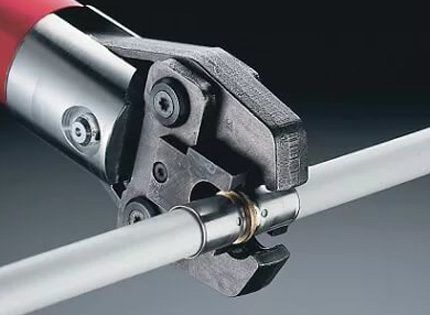
Regardless of the installation conditions and the technologies used, the installation of water supply or other communications based on metal-plastic pipes is accompanied by tests for tightness and strength.
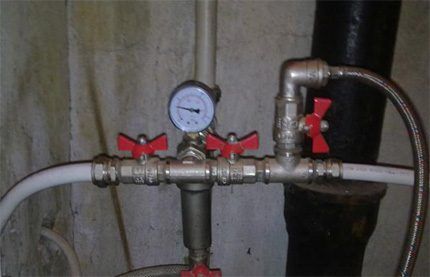
Usually, test process carried out hydraulically. But the possibility of testing using the pneumatic method is not excluded.
Methods for crimping metal-plastic
The hydraulic method involves filling metal-plastic pipes with water and then increasing the pressure to set values. Tests may affect the entire installed highway or only individual sections of it.
The pneumatic method uses compressed air instead of water. This crimping method is considered less effective and more dangerous compared to the hydraulic option. And it doesn’t matter whether metal or metal-plastic pipes are tested.
Option #1: hydraulic
The process is no different from the standard version, which is used on steel water mains. The only caveat is that the operating pressures for plastic pipes are lower than those accepted for metal products.
Accordingly, the test pressure is calculated taking into account standard operating pressure settings for plastic according to the formula:
Ri = Ррп * 1.5,
In it, Ri is the test pressure; Ррп – working pressure of a plastic pipe.
The water temperature inside the pipeline is allowed within positive values of 5 - 40ºС.
Progress of the procedure:
- Prepare the test area (install taps, plugs).
- Install 2 pressure gauges at different points in the line.
- Install an air vent at the upper level of the line.
- Connect the water pump at the lower level of the line.
- Fill the line with water supply from the lower level to the upper level.
- Open the air vent to bleed air from the system.
Inside the highway from metal-plastic pipes The pressure should be increased slowly, excluding sudden jumps. Such pressure pumping conditions are provided by a manual hydraulic press.
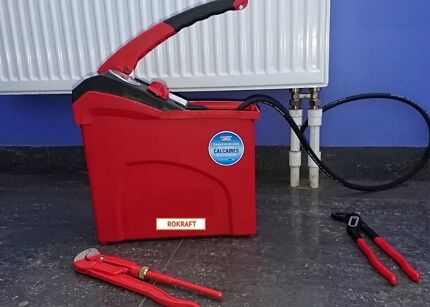
Until the pressure value approaches the operating level, it is recommended to periodically visually monitor areas of possible leaks.
These areas are usually:
- pipe-in-pipe connections;
- contact between pipe and fitting;
- installation points for taps and plugs.
Increasing the pressure inside metal-plastic pipes to a value exceeding the operating parameter by 1.5 times is allowed only in the absence of people near the tested line.
The established test pressure inside the pipeline must be maintained for a certain time. For water supply systems made of metal-plastic pipes designed for use in domestic conditions, a five-minute minimum holding period is adopted.
During the accepted minimum test time, a pressure drop at the installation points of control pressure gauges is not allowed. When negative changes are observed on control instruments, this condition indicates incomplete tightness of the system.
The pressure should be reduced to the operating value and carefully checked for possible leaks throughout the entire section of metal-plastic pipes. Eliminate detected defects and repeat the test procedure.

Leak tests are passed when they satisfy the following conditions:
- no leaks were visually detected;
- no pipe wall ruptures were visually detected;
- for five minutes there were no changes in pressure on the control pressure gauges;
- there are no visible deformations of the pipelines.
Meanwhile, it is necessary to clarify: if the time delay exceeds a five-minute interval, a slight drop in test pressure is allowed due to a natural change in the temperature of the water inside the metal-plastic pipes.
Option #2: pneumatic
If it is impossible to carry out hydraulic pressure testing for some reason, an alternative is allowed - pneumatic testing.
The pneumatic test method differs in a slightly different way of checking for leaks, but in general it practically repeats the hydraulic method. This technology is not used so often on pipes, but it is widely used for crimping individual devices, such as expansion tanks, boilers, heat exchangers, etc.
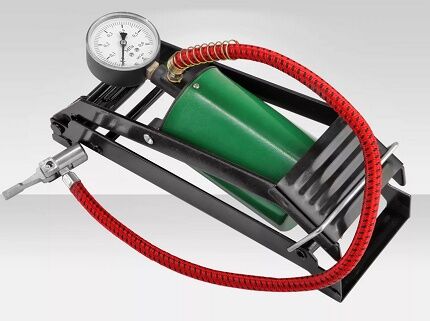
To detect leaks under pneumatic pressure testing, a soap solution is usually used. The assembled line is filled with air under pressure Pu = Ppp * 1.15 and areas of potential leaks are irrigated with a soap solution. The release of air is determined by the swelling of bubbles.
This testing technique allows you to visually detect even minor leaks. But it is quite difficult for the inspector to monitor the presence of leaks in places that are difficult to reach for visual observation.
The pneumatic test method is quite suitable for testing the tightness of connections metal-plastic pipe fittings or according to the “pipe in pipe” scheme. But when you need to test the strength of a pipeline system, this method is clearly not the best. Here it is necessary to resort to hydraulic testing.
Crimping as a connection method
The practice of installing metal-plastic pipes is marked by the use of several methods suitable for making all kinds of connections:
- soldering;
- nut;
- crimping
The last method of the three is precisely crimping a metal-plastic pipe in the area of its junction with the fitting.
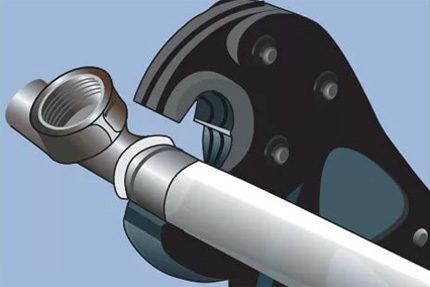
The technique of such crimping is distinguished by simple actions that can be performed even by a non-professional plumber. The only caveat is that the work requires the so-called press jaws – a special tool that creates a reliable crimp connection.
In general, the following set of tools is required to perform work using the crimping technique:
- pipe cutter for metal-plastic pipes;
- calibrator, expander, chamfer processor;
- press tongs.
A pipe cutter produces an even cut to a given size, without deforming the pipe and at a right angle. Using a calibrator and chamfer processor, the end part of the metal-plastic hose is prepared for subsequent connection with the fitting.
Sometimes an expander is needed for work. Press jaws occupy a special place in the process. It is with the help of this tool that the prepared connection is crimped.
In the assembly of metal-plastic pipelines, crimp and compression (aka threaded) fittings are used, the steps for their installation are largely similar:
How to crimp a metal-plastic pipe
The crimping procedure for connecting a metal-plastic pipe with a fitting involves the following sequence of actions:
- Cutting a metal-plastic pipe to size.
- Performing calibration of its end sections.
- Chamfering along the inner radius.
Then the crimp sleeve is installed on the end of the pipe.
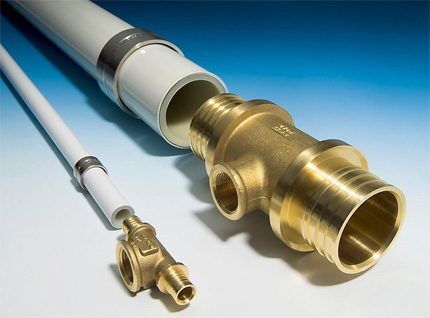
After these steps, the fitting part of the fitting is inserted into the metal-plastic pipe from the end where the crimp sleeve is located. Move the crimp sleeve along the pipe body and install it parallel to the fitting. Guidelines for working with press fittings in the assembly of a metal-plastic pipeline given here, We recommend that you read the useful information.
Apply press pliers to the joint area, supplemented with equipment corresponding to the diameter of the pipeline being processed. Squeeze the handles of the tool until they stop.

Such actions are typical for performing crimping using hand tools. Meanwhile, in addition to manual crimping, there are electrical, hydraulic, and pneumatic devices.
These design options are usually rarely used in everyday life. Their purpose is the industrial production sector. In configuration, they are also very different from manual models.
It is worth noting some features when working with press jaws. Only one-time crimping is always allowed. If for some reason you were unable to perform a high-quality crimp the first time, you should not try to repeat the action. The defective crimp must be removed and the crimping procedure must be performed first.
Advantages and disadvantages of crimping
Evaluating connection of metal-plastic pipes, made using press jaws, one cannot fail to note the advantages and disadvantages.

Both one and the other determine the conditions where this particular method is suitable.
The list of noted benefits is as follows:
- an unattended connection is created;
- Design for high operating pressures;
- high mechanical strength;
- long service life;
- easy, simple and quick installation.
From the point of view of existing shortcomings, experts also identify some factors and usually associate them with maintenance or installation criteria:
- a permanent connection is created;
- A special tool (press pliers) is required.
The downside is that every crimping error reduces all the work to zero.
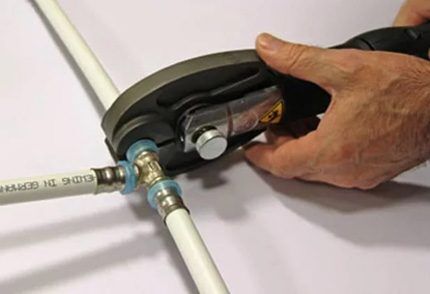
In addition to these disadvantages, you can add the high cost of the main tool - a tong press.
True, manual adaptation for living conditions is not as expensive as automatic designs. But even in this case, it is not profitable to buy, since the need for the tool is actually one-time.
Conclusions and useful video on the topic
From the video you can learn how to work with mechanical press pliers, namely, how to crimp metal-plastic pipe fittings.

It is recommended to install metal-plastic pipes using the crimping method in environmental conditions with a temperature not lower than +10ºС. It is advisable to keep the purchased material (pipes) in new conditions for at least 24 hours and only then begin installation.
The installed water supply system must be tested for tightness and strength through hydraulic and pneumatic tests.
Do you have experience working with metal-plastic pipes and making their connections? Do you know the technological subtleties of producing this work that are not covered in the article? Please write comments in the block form below, ask questions, post photos.




If you have the necessary tools (a special pipe cutter and press pliers), performing crimping of metal-plastic pipes is not a big problem and is quite easy to do yourself. If something is not clear, then just watch a couple of videos, which are full on the Internet. Another thing is that not everyone has the tool, and it is not cheap.
Yes, there is no point in buying them if you don’t do it professionally. I just rented these press tongs; now there are a lot of companies where you can do this.
Hello. When making pipes, is it necessary to chamfer the cut area?